It’s the first few minutes of a bike launch and I’m having to try quite hard not to weep. The scepticism brought about by predictably dramatic music, followed by an unexpected big name actor are gone. Instead I’m lost in wonder at how the copywriter behind the video I’m watching has captured some bit of my soul and turned it into an advert for a bike I’m about to ride.
https://www.youtube.com/watch?v=e9yoEMiCOP0&t=38s
I kind of get it: the relationship between you and your bike is like a friendship. Just as friends can give you the confidence to be a better, stronger person, so the right bike can give you that feeling of being a better rider: trail features pass under your wheels as you feel your confidence and grin grow. While the script might say a lot about what I feel about the importance of friends, it’s a pretty over the top piece of marketing for a bike and I’m not going to drink the Kool Aid. I’m going to ride this bike in spite of the marketing, and see how it makes me feel. Is there a friendship to be had, or just a brief acquaintance?
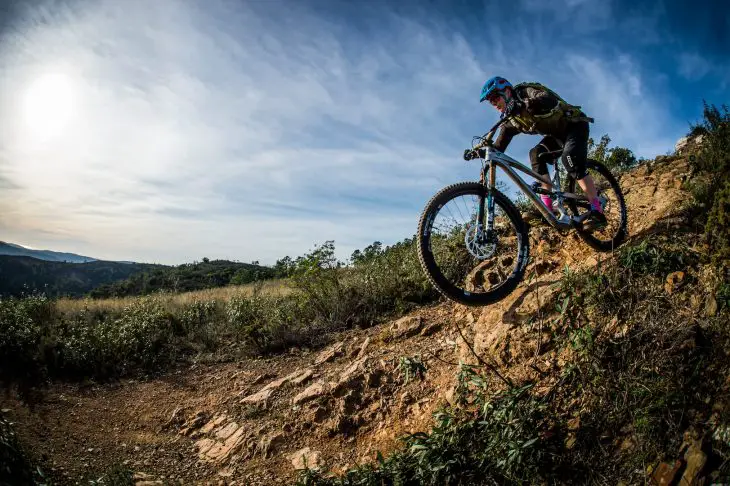
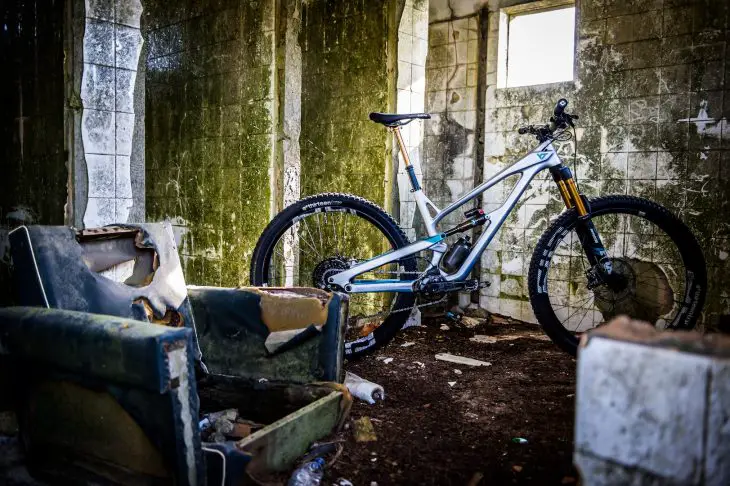
The Bike
The original Jeffsy was launched a couple of years ago to the tune of a video which I found much less compelling. That didn’t stop the masses loving the bike though, and it’s been hugely popular. We tested the alloy version and Barney thought it was ‘an extremely impressive setup’. Barney being significantly larger than me however, I’d not had the chance to ride the Mk1 model, leaving me to look at the numbers to understand the differences that have been designed into this Mk2 model.
The Jeffsy sits below the Capra – an enduro offering that will accept a downhill fork – and has been pitched as a trail bike. However, the new model is pushing the definition of trail bike and we can’t help think that maybe there’s a bit of a shuffling up of radness that will leave space for something shorter travelled in the next model year or two. As it stands, the Jeffsy now comes in 27.5in 160mm or 150mm versions, or for 29er models both 150mm or 140mm are available. And, you can have carbon fibre or alloy in both wheels sizes, though only in the shorter travel models. In all, there are four models in each wheel size, with two colours at each price point.
I would be riding the 29er, in top of the range longer travel CF Pro Race guise. The standover has been increased to recognise the greater selection of longer dropper posts now on the market. Riders can now size up or down according to their reach preferences rather than the need to clear the top tube. There is now an extra size in the 29er line up, with five sizes from Small to XXL. If you want to go long, the XXL now offers a reach of 510mm (514 in the non-Race carbon fibre and alloy models). Coming from riding a Specialized Stumpjumper and Norco Fluid with reach measurements of 425mm and 440mm respectively, I opted for a Medium Jeffsy, which features a 450mm reach – a Small would have have been between the reach of the bikes I’m more familiar with. Between wheel size, travel, frame construction and frame size, that’s a lot of choices to be made.
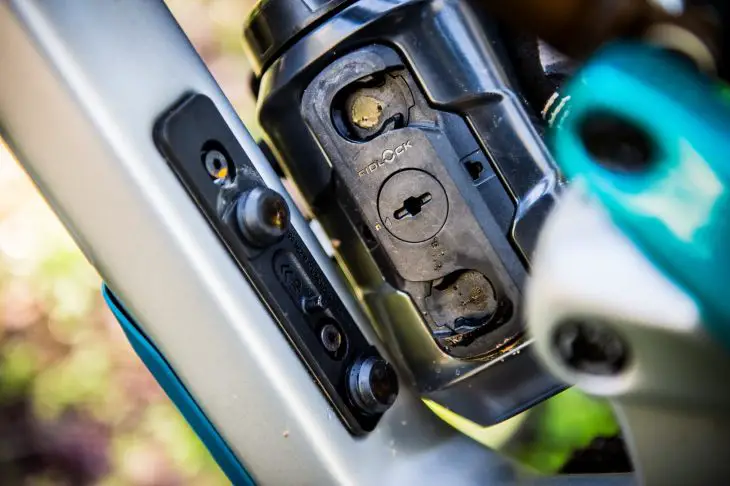
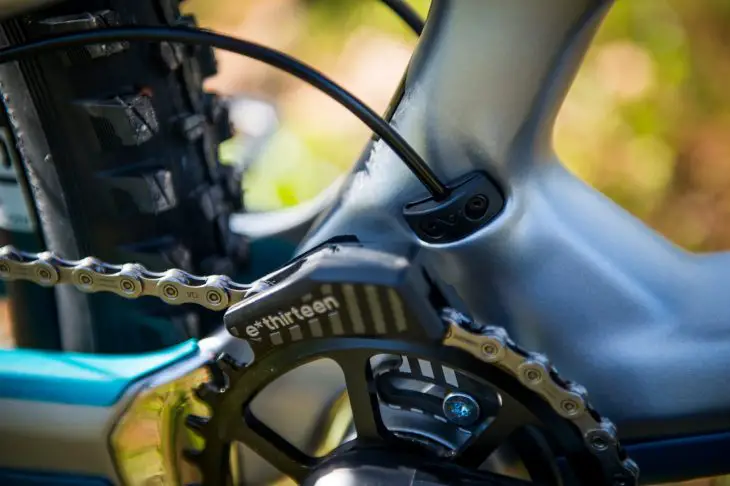
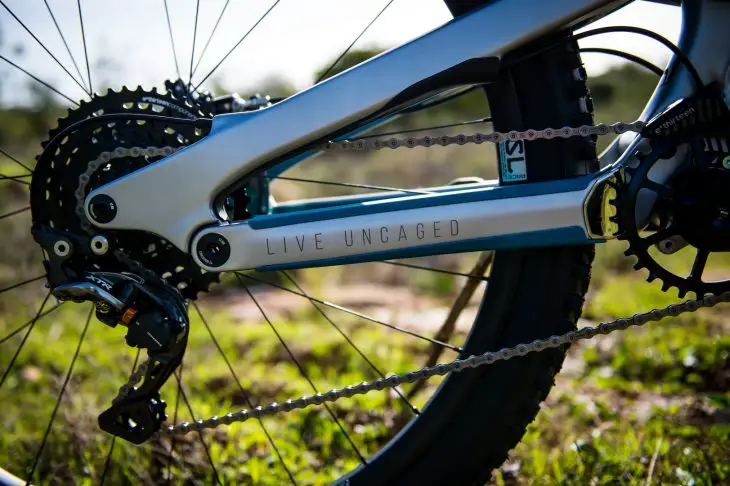
Chainstay lengths are varied according to size with the XL and XXL getting 440mm and the others size getting 435mm. The flip chip – to steepen the head tube angle and raised the bottom bracket – remains, while frame construction has been altered to create enough room for a 600mm Fidlock bottle in all the sizes. If you don’t want to use this magnetic arrangement, there’s a cover plate that will keep the water out of your frame, or which will accommodate a standard bottle cage (though then you’ll only fit a 500ml bottle in there on size large and up, but it may come in handy for a tool keg). Overall frame stiffness has been kept the same, but the front of the bike has been stiffened to give it burlier feel as you tackle big hits, without losing some of the comfort and flex of the Mk1 back end.
YT has put its experience of the demands of World Cup racing into the bike, making a number of tweaks which riders (or mechanics) should find increase durability and ease of maintenance. The down tube protector is bolted rather than glued on, and the insides of the chainstays are protected by metal plates to prevent the chain damaging the carbon – particularly useful perhaps if you do a lot of removing of the rear wheel for transport. The rear linkage has been designed to be as flat as possible to prevent there being a mud shelf, and both linkage bearings have had additional seals added to prevent water penetration. Apparently these have been tested on the World Cup team bikes and their demo fleet for a year and the results show a 100% increase in the operating life of the bearings. Another legacy of the team’s input is that the bike can be serviced from one side – all the bolts do up on the same side, to save swapping round the workstand. Handy if you’re a pro mechanic in a hurry, but perhaps also if you’re the average Joe with a tiny corner of the shed to do your maintenance in.
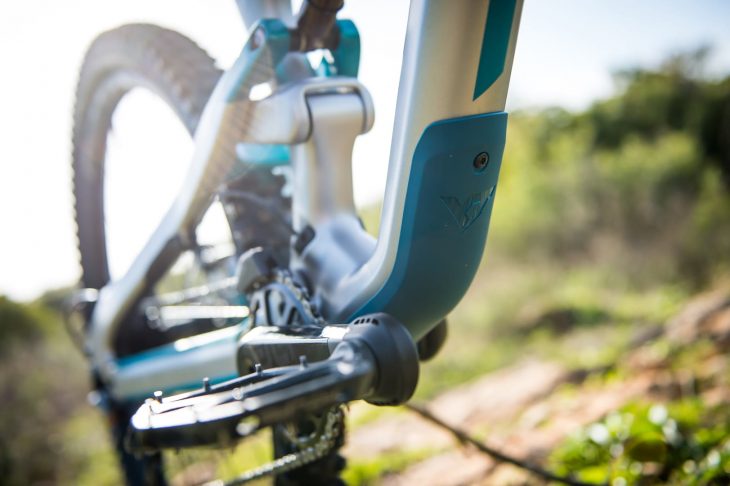
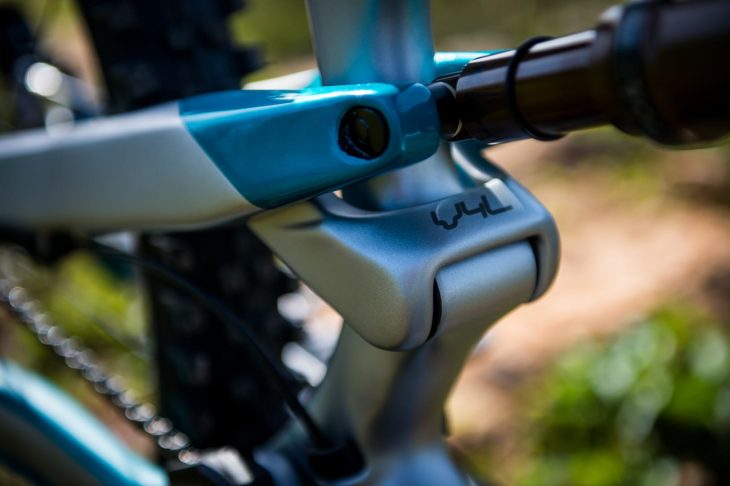
Some emphasis has been put into making the bike easier to pedal, with a steeper seat tube angle as well as kinematics that have been altered to provide greater anti-squat properties. Suspension has been made more consistent, with a flatter leverage ratio curve across the longer travel of the new metric shock sizing.

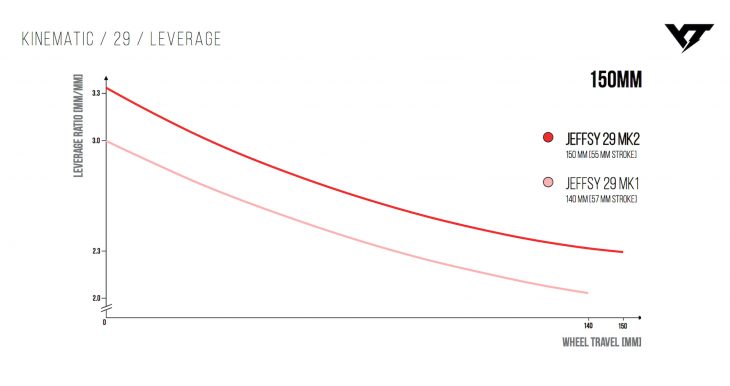
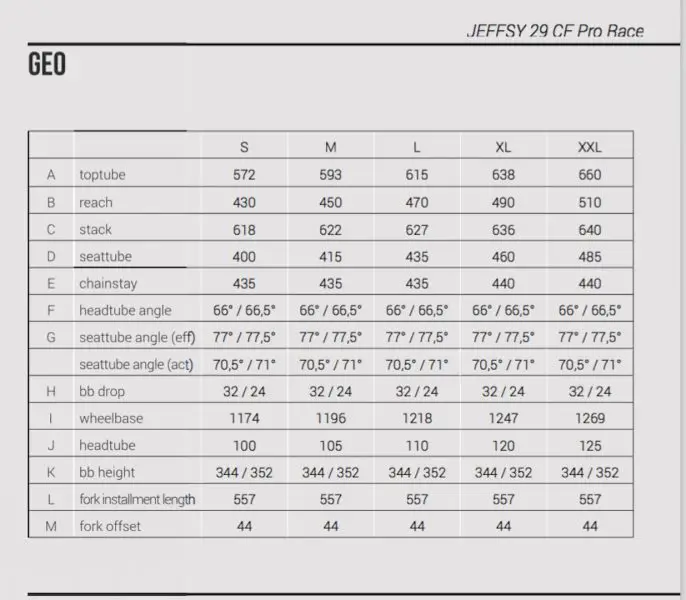
The Ride

While it didn’t feel vast to ride round the car park, after a couple of big descents on technical trails my arms were in ruins. Quivering little twigs of fatigue dangling from tired shoulders. Admittedly I was riding technical trails at the limits of my previous experience, and I’m not a shuttle rider – standing up and rolling down is not my usual bag (though I can definitely see the fun in it), so I was using muscles I don’t really have. But the length of the bike was definitely playing a part.
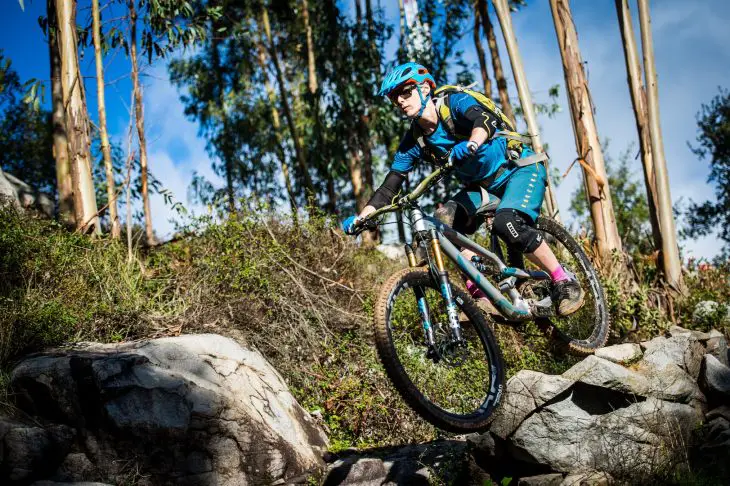
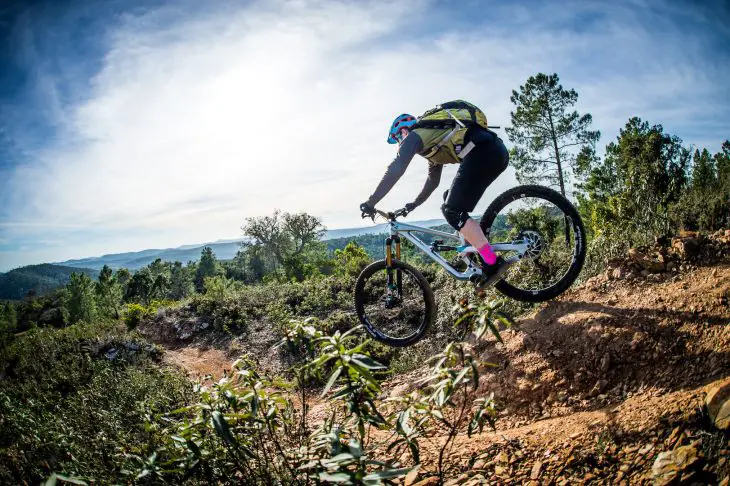
Repeatedly casing a jump, I was finding I was unable to shift my weight enough between my arms and legs to get the pop needed to manipulate the bike into position in the air. I suspect that a combination of being unused to the extra reach, plus the 800mm bars, plus the uplift meant I was initially using muscles at the limits of their strength and capability. A slight turn of the bars towards me combined with swapping the stock 50mm stem to a 35mm one, and the ride experience was transformed. My arms immediately recovered and I found myself rolling down drops I didn’t think possible, then going back and doing them faster, then going back and treating them as jumps instead of drops. Any concerns I’d had about having chosen a too-big bike were gone, and with my arms better positioned for balance I set about having as much fun as possible.
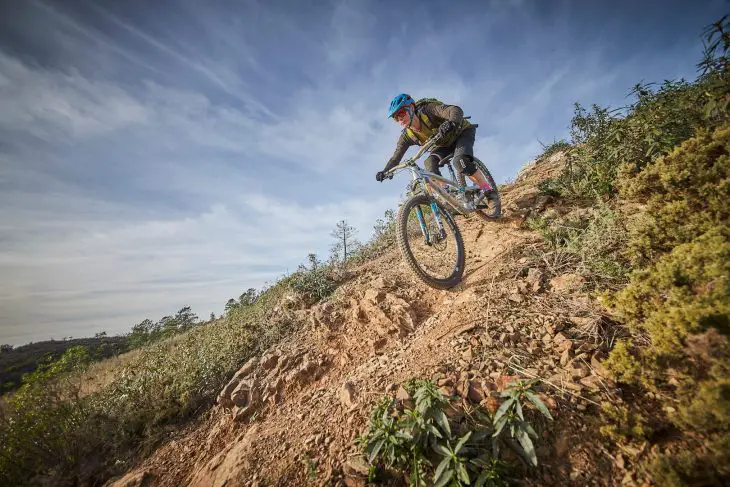
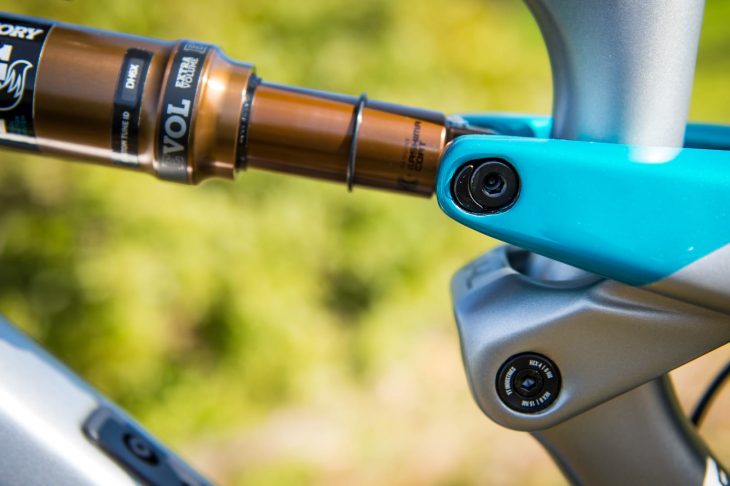
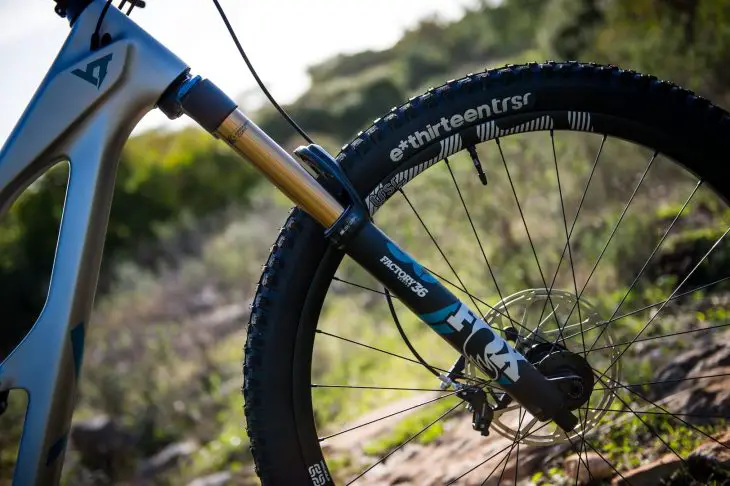

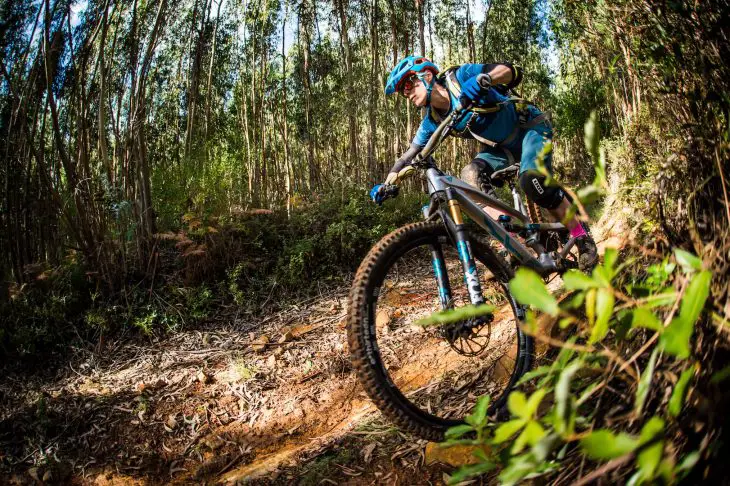
It never does you any harm to have your bike set up by the person who designed it, or by a pro racer, and I found myself having mine set up by both. I started out with the 50mm stem and just over 25% sag in the shock with 5 clicks of low speed compression. The fork was set at 25% sag with 3 clicks of low speed compression, and 2 clicks of high speed. Swapping a spacer and the stem to a shorter 35mm option gave me a slightly higher position on the bike. Part way down another run and the fork was tweaked again to increase the compression damping – 4 high and 6 low – to compensate for the slightly higher rider position. In both set ups, I was pushing the bike hard – not necessarily always in a skilful way – and was getting full travel from both the shock and fork, but never blowing right through – but the slightly shortened version definitely suited me better. There was no need to think about suspension behaviour, and I was free to focus (pretty hard) on the rocks, drops, chutes and turns that were appearing before me – mostly in quick succession and combinations which, had I thought too hard about them, I probably wouldn’t have ridden.
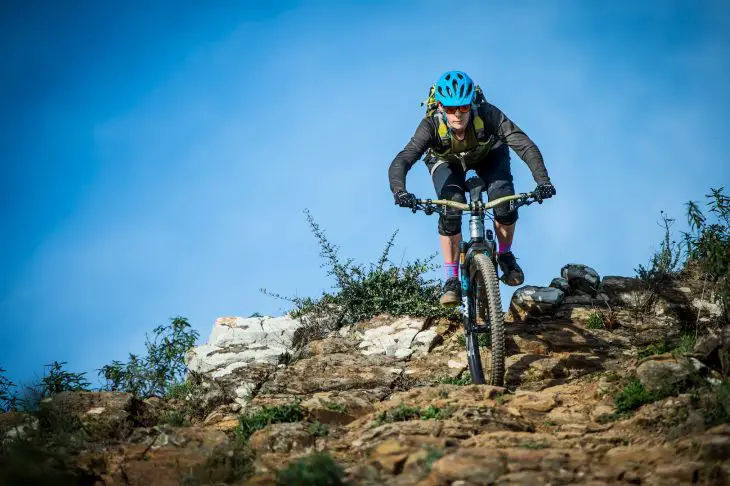

The test terrain varied between nicely tacky and sticky slippery, with plenty of rocks sticking through at the kind of pointy angles that seem perfect for shredding sidewalls. While others on the ride did puncture, I did not, and the E13 TRS Race tyres seemed nicely grippy and chunky for the terrain. Perhaps I could have risked a slightly lower tyre pressure for even more grip, but with so many sniper rocks around I erred on the side of caution.
I really liked the SRAM Guide RSC brakes – which is just as well as I was certainly making use of them. I’m not a naturally fast rider, I like to be able to see what’s ahead and process how I’m going to navigate it, so riding blind I’m definitely on the cautious side. Riding trails almost perfectly graded to maintain rolling speed, throw you into steep switchbacks, and spit you out the other side all the while carrying speed…well, I admit to dragging the brakes a fair amount. This was made much easier by the easy reach adjust combined with the separate pad adjust dials. My single fingers clinging to those brakes were able to do so without screaming with exhaustion. I’d not used these brakes before, I want to use them again, please.
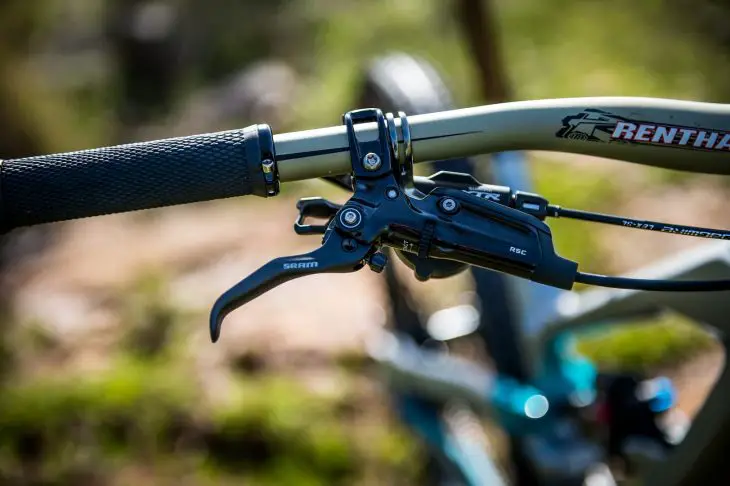
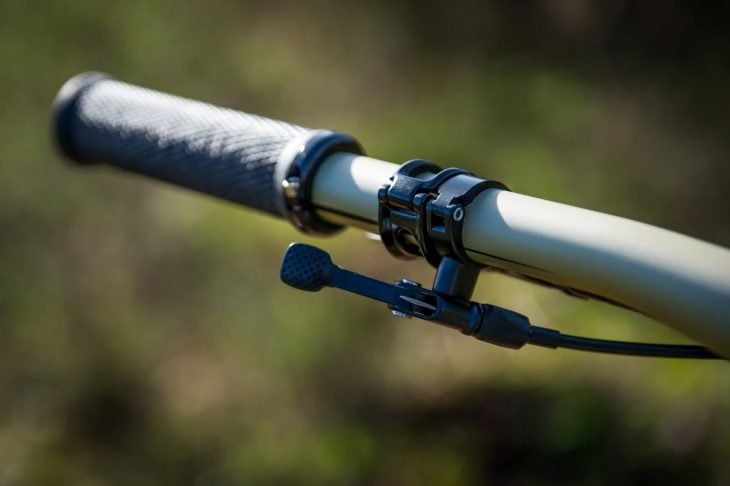
The Fox dropper wasn’t used too much – in that with shuttling being the name of the day, it mostly went down and stayed down. If I was being picky, I’d like the actuator to be a bit larger for more mixed up and down, pedal and roll riding, where hitting the paddle with your thumb can often be done rather later as you switch between pedalling and plummeting. Of course, there are also plenty of after market options for this available and it’s only having used these that I’m probably able to be critical of the Fox one.
While there wasn’t too much by way of technical trail pedalling to be done, there were a few decent climbs to get up to the trail heads. I found that here the bike was perhaps a little harder to keep weighted on the front than I would ideally want in a trail bike that I’d be taking for big days out, but with such limited climbing opportunities there wasn’t a lot of time to tweak saddle positions for optimised climbing. Indeed, my bottom barely touched the saddle for the whole two days, as my quivering thighs would attest. For winch and plummet style riding where the ups are more fireroad than singletrack, the bikes certainly pedals comfortably – and there were pros there who climbed up what certainly looked impossible to my mortal eye. Before commenting further on the technical climbing ability, I’d like to spend more time on trails like there are at home in the Calder Valley, where you often need to both sit-and-spin and heft-and-hup (Not with me? Say that out loud and you will be). That said, on a short section of repeated climbing for the camera, I did find I was already getting more used to the bike and getting further up the trail each time.
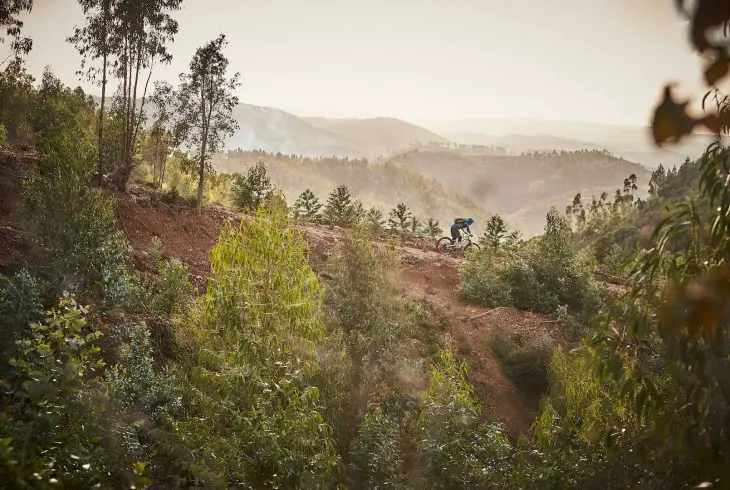
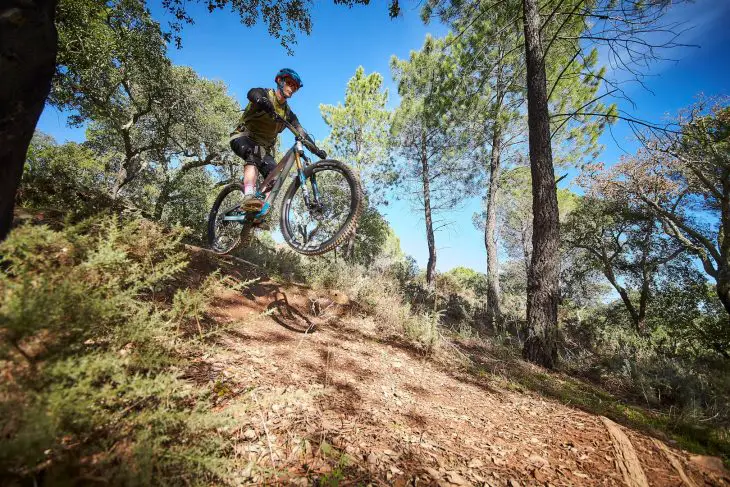

It is a super aggressive and burly trail bike – really I’d be tempted to say it’s an enduro bike, with the Capra perhaps being an enduro bike with DH proclivities. Certainly, I doubt there’s much in the UK you couldn’t ride on this bike – I’ve not ridden Fort William, but Chipps has on a Saracen Ariel, which I then borrowed for Foxhunt. I’d happily take this Jeffsy anywhere I’d have taken that Ariel – and since it pedals better and I found the handling more nimble, I’d take it more places too. So perhaps by extension I’d get down the Fort William track on this…strangely enough, I’d quite like to try.
Maybe you’re getting the idea that I quite liked this bike. You’d be right. I’m not sure it’s the bike for me, who rides the kind of trails where the ups are part of the fun and doesn’t get too many big descent options. However, if I lived somewhere nearer an uplift or where I could cruise up fire roads before repeatedly taking some gnarly trails down, I’d certainly have an eye on this bike. It’s made me look at gnarly trails with greater enthusiasm too – it turns out I can ride more, harder and faster than I thought. Riding in Portugal I repeatedly ignored the voices of alarm in my head and pushed the bikes into situations I wasn’t sure I’d get out of – and repeatedly did. The stiff front end worked with the suspension to mean that even in steep rocky turns the front wheel tracked where I wanted it to and came out the other side – no pinging around or noodling about making me wrestle the bars or shift my weight out of balance. It’s a bike that instils trust – so maybe, just maybe, that marketing isn’t quite so bonkers and you might at first be tempted to think.
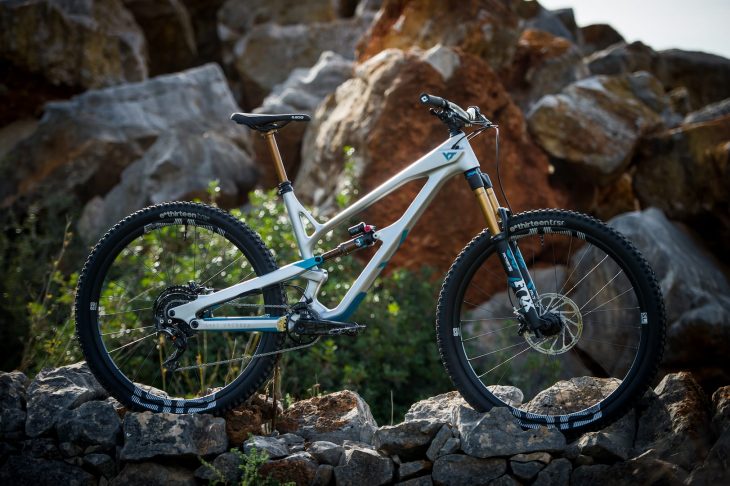
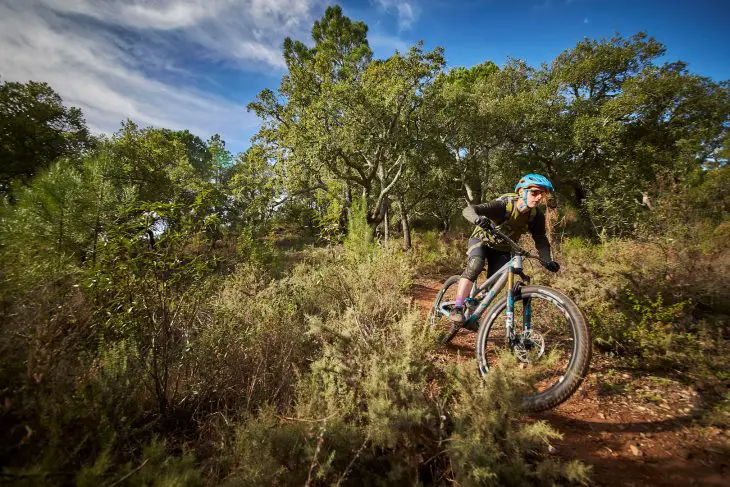
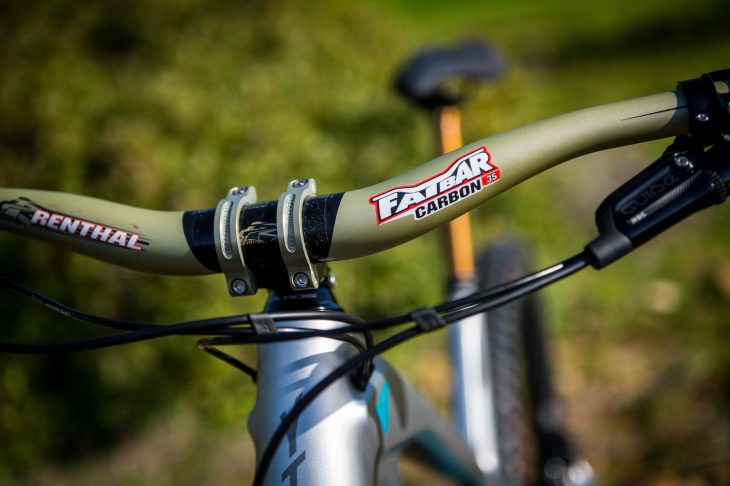
Three things I’d change
- The Fox Transfer actuator. It’s not by any means terrible, but there are better ones out there.
- I needed the shorter stem – it transformed my experience of the bike.
- It’s all a matter of personal taste, but the colours don’t really rock my world. Maybe they could get their mechanic, Lars, who is also a custom bike painter, to come up with something a little more ‘ooh’.
Three things I loved
- The suspension tuning – loads of support through big hits, but still soaking up the endless rocky chatter I tackled over the two days of riding.
- The low standover – I like the feeling of having the bike well below me without fear of any awkward or painful emergency dismounts
- The burly feel – hit stuff well or wrong, the bike will take it and pull you through.
Overall
It’s never a good idea to say ‘could we just have one last run’ but with this bike I really wanted to, despite two days of riding which would find me waking up on departure day stiff and sore in the way that usually only a tough gym session induces. This is definitely a bike that had me wondering what I could jump off next, or ride faster next time. Perhaps more of a holiday romance than a lifelong friend for me and my typical ride needs, but I’m certain that for many this bike will be less of a fling and more of a day to day companion.

Specification: YT Jeffsy 29 CF Pro Race
Fork// FOX 36 Float Factory 29“ | 150mm | Grip 2 | 15QRx110 | 44mm Rake
Shock// FOX Float DPX2 Factory 210x55mm | 3pos-Adjust | Evol LV
Headset// Acros AZX-203 High Cap
Stem// Renthal Apex 35 50mm
Handlebar// Renthal Fatbar Carbon 35 30mm Rise | 800mm Wide | Gold
Grips// ODI Elite Motion Lock-On
Crankset// E13 TRS Race 175x73mm | 32T Boost
Chainguide// E13 TRS Race SL I05 | 28-36T | Compact Slider
Cassette// E13 TRS Plus 9-46T | 11-Speed
Rear Derailleur// SHIMANO XTR Shadow Plus | 11-Speed
Shifter Rear// SHIMANO XTR 11-Speed
Wheels// E13 TRS Race Carbon 29“ x 28mm | 110x15mm | 148x12mm
Tyres// E13 TRS Race | TRS Plus 29“ | 2.35
Brakes// SRAM GUIDE RSC Rotor CENTERLINE 200mm/180mm
Seatpost// FOX Transfer FACTORY Ø 31.6mm | 125mm/150mm Drop
Saddle// SDG FLY MNT YT Custom | Silver
Claimed weight// 12.9kg in size Small.
Disclosure
Hannah’s travel and accommodation was covered by YT Industries.
Review Info
| Brand: | YT Industries |
| Product: | Jeffsy CF Pro Race 29 |
| From: | yt-industries.com |
| Price: | £4,799 |
| Tested: | by Hannah for 2 days |
Comments (6)
Leave Reply
Post Comment
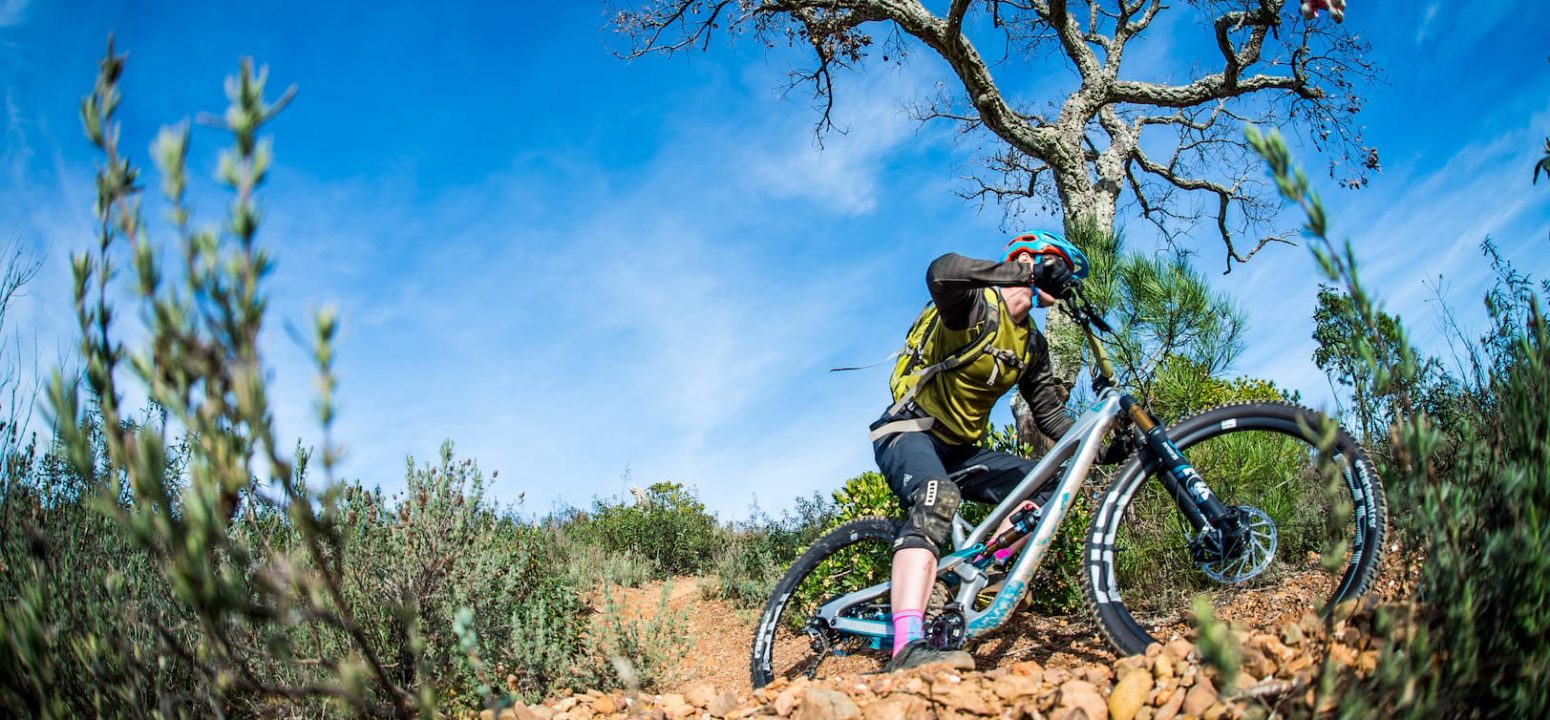


@rene59 Nope – if only that were the case, we could all have an extra biscuit with our tea. If we’ve been paid for something it will be marked as ‘Sponsored’, and where we’ve received free travel or accommodation that’s in the bottom of the article in a disclosure. Chipps wrote about our position here: https://singletrackworld.com/2017/08/declaring-an-interest/
How does the new Jeffsy compare to the Stumpjumper in terms of being the “Ultimate trail bike”? My impression is that the Jeffsy is more enduro than the Stumpjumper, or am I wrong?
@mfacey I rode the Stumpjumper Expert Carbon 29 last summer. I’d say you’re about right in your assessment…but they’re both super capable bikes. I think a lot of it would come down to what ride position you prefer – the Stumpy is a lot shorter. Plus, what sort of terrain you’re looking to ride. I did ride a lot of things I surprised myself with on the Stumpy, but then I’ve progressed some more and rode a lot more scary stuff on the Jeffsy. Given that skills progression, I’d want to do a back to back ride on each to judge accurately what’s bike and what’s me, but I think that on the whole I’d agree the Jeffsy is definitely on the enduro end, whereas the Stumpy – especially with the plus tyres – is more trail.
@mfacey according to a few American magazines / websites, and the best European on, http://www.enduromtb.com the Ibis Ripmo has won the accolade if ultimate trail bike for 2019.
Thanks Hannah.
I know the travel & geo differs but how does the Jeffsy compare to the Ibis Ripmo & Yeti SB130?
@doncha I’ve only ridden the SB130 for about 10 minutes of a photoshoot, and never ridden the Ripmo, so I’m afraid I can’t give you any insight there. Chipps does really really rate the Ripmo (see his Editors’ Choice in Issue 122), but since he hasn’t ridden the other bikes you’re asking about, he’s no good for a comparative response either, sorry!